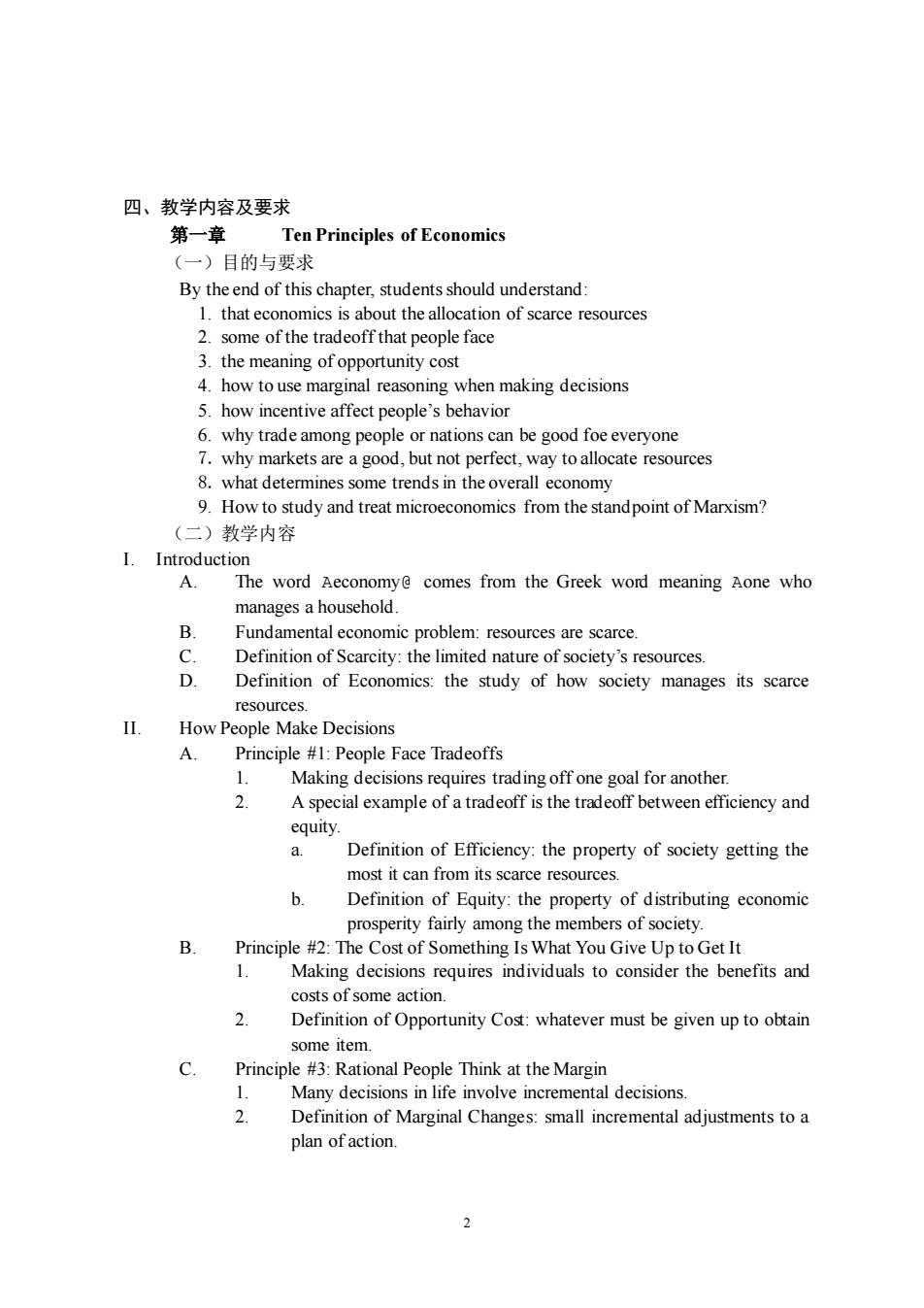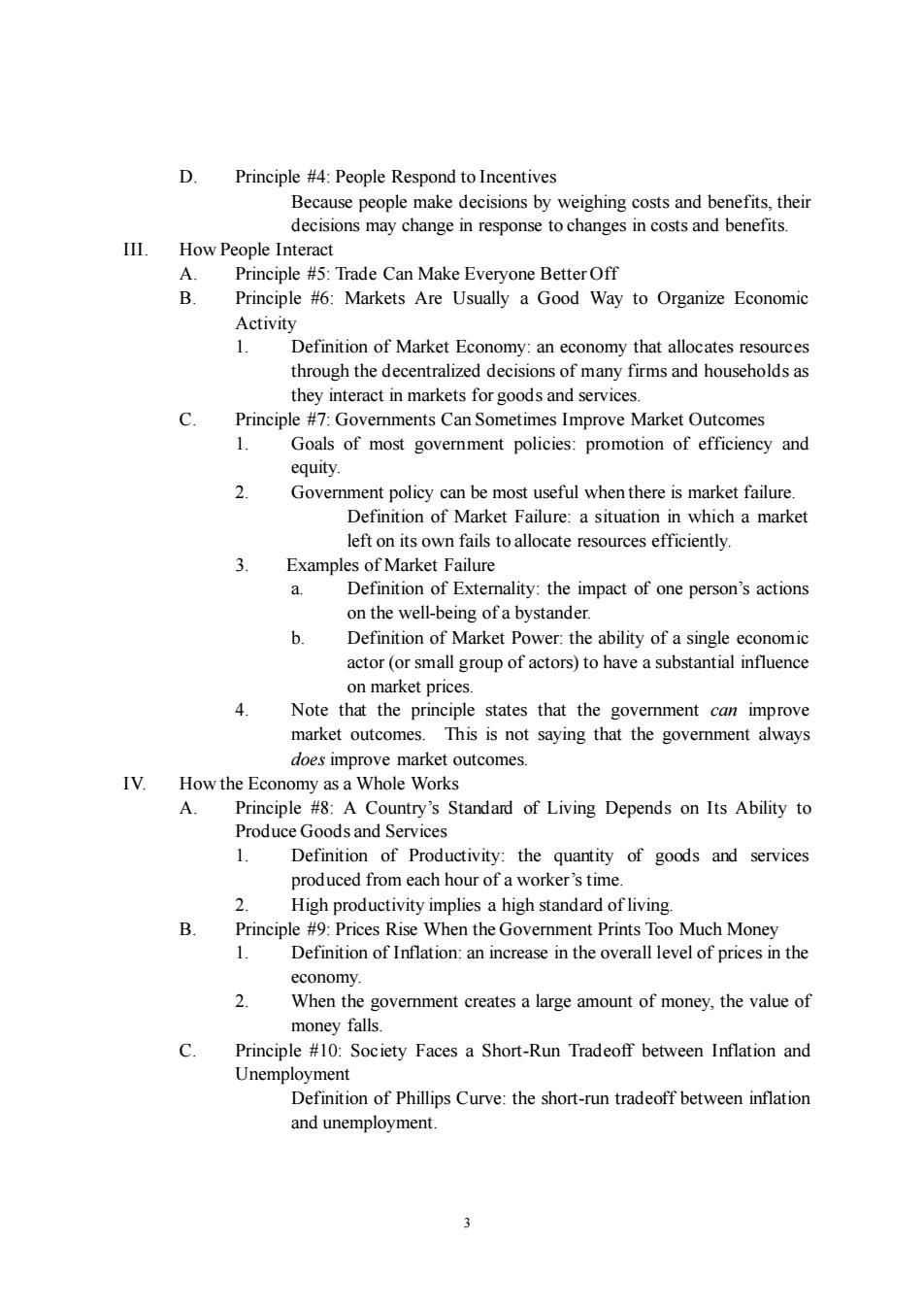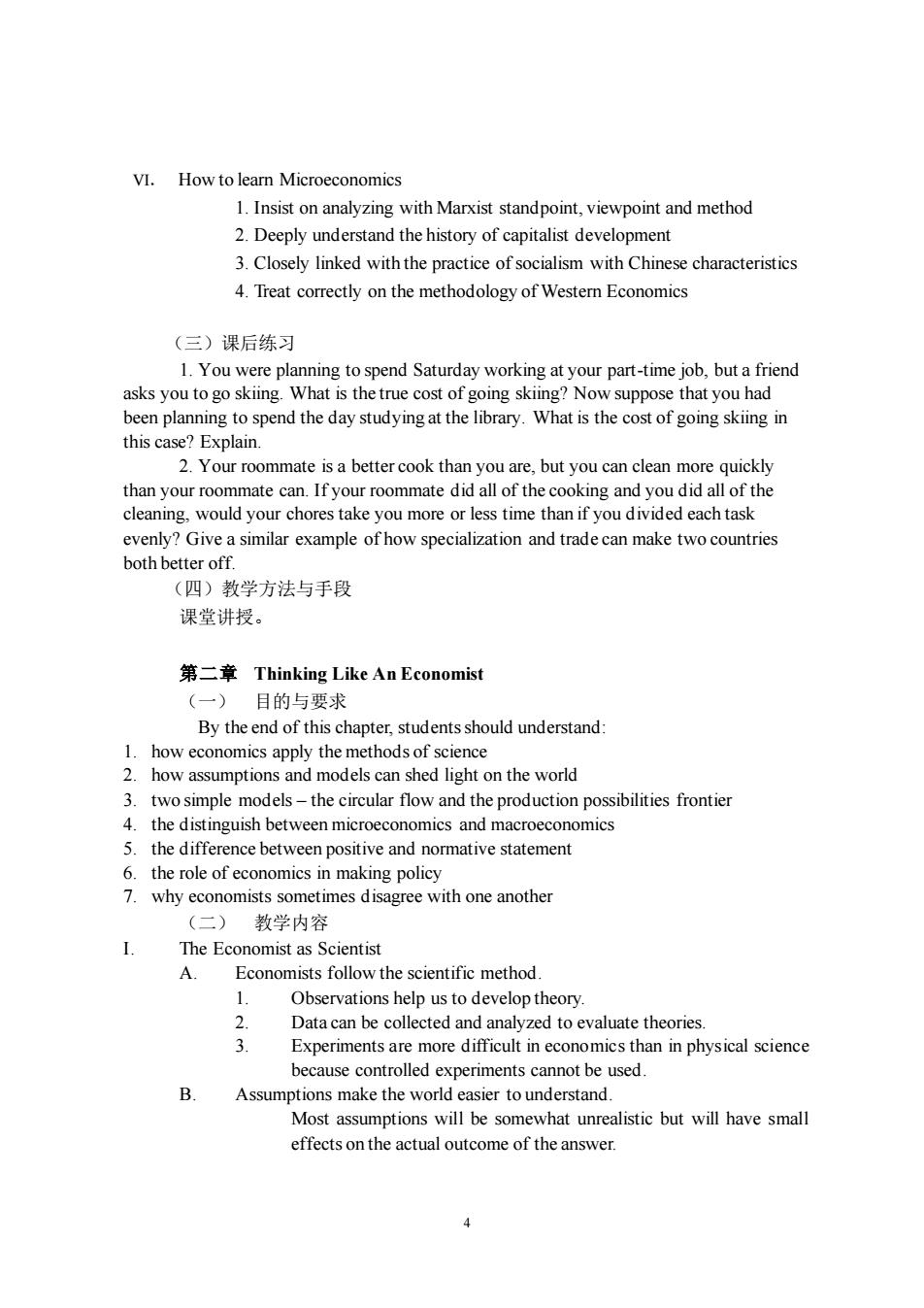
《微观经济学》(双语)课程教学大纲 一、课程基本信息 课程代码:18060013 课程名称:《微观经济学》(双语)》 英文名称:Microeconomics 课程类别:学科基础课 时:48 学 分分:3 适用对象:经济管理类 考核方式:考试 先修课程:高中数学 二、课程简介 中文简介 作为微观经济学的第一门课,本课程将向学生提供这一领域的基本观点、基本概 念和分析工具。学生将学习市场如何运做,各个经济主体如何做出决策,以及他们对 资源配置的含义。本课程将包括:对一些基本经济原理的介绍,供给和需求,市场与 福利,公共部门经济学,企业行为与产业组织等。本课程将更多地侧重应用与政策。 英文简介 As the first course of microeconomics,this course will provide students with the fundamental ideas.basic concepts and techniques in this field.Students will study how the markets work,how the economic agents make decisions,and their implications for the allocation of resources.This course will includes:Introduction to Some Principles of Economics,Demand and Supply,Markets and Welfare,the Economics of the Public Sector Firm Behavior and the Organization of Industry,etc.More of this course is devoted to application and policy 三、课程性质与教学目的 微观经济学是经济管理类专业的基础课,揭示了关于现代化大生产、市场经济运 行和资源配置机制、政府宏观调控和企业管理的基本规律,也反映了发达资本主义国 家特殊的阶级利益、制度属性和意识形态。学习该课程,需要以马克思主义理论为指 导并从中国实际出发,遵循理论移植规律,紧密联系当代中国特色社会主义丰富实践, 客观认识西方经济学,取其之精华、去之糟粕。 1
1 《微观经济学》(双语)课程教学大纲 一、课程基本信息 课程代码:18060013 课程名称:《微观经济学》(双语) 英文名称:Microeconomics 课程类别:学科基础课 学 时:48 学 分:3 适用对象: 经济管理类 考核方式:考试 先修课程:高中数学 二、课程简介 中文简介 作为微观经济学的第一门课,本课程将向学生提供这一领域的基本观点、基本概 念和分析工具。学生将学习市场如何运做,各个经济主体如何做出决策,以及他们对 资源配置的含义。本课程将包括:对一些基本经济原理的介绍,供给和需求,市场与 福利,公共部门经济学,企业行为与产业组织等。本课程将更多地侧重应用与政策。 英文简介 As the first course of microeconomics, this course will provide students with the fundamental ideas, basic concepts and techniques in this field. Students will study how the markets work, how the economic agents make decisions, and their implications for the allocation of resources. This course will includes: Introduction to Some Principles of Economics, Demand and Supply, Markets and Welfare, the Economics of the Public Sector, Firm Behavior and the Organization of Industry, etc. More of this course is devoted to application and policy. 三、课程性质与教学目的 微观经济学是经济管理类专业的基础课,揭示了关于现代化大生产、市场经济运 行和资源配置机制、政府宏观调控和企业管理的基本规律,也反映了发达资本主义国 家特殊的阶级利益、制度属性和意识形态。学习该课程,需要以马克思主义理论为指 导并从中国实际出发,遵循理论移植规律,紧密联系当代中国特色社会主义丰富实践, 客观认识西方经济学,取其之精华、去之糟粕

四、教学内容及要求 第一章 Ten Prineiples of Economics (一)目的与要求 By theend of this chapter,students should understand: 1.that economics is about the allocation of scarce resources me of the tradeoff that people face 3.the meaning of opportunity cost 4.how to use marginal reasoning when making decisions 5.how incentive affect people's behavior 6.why trade among people or nations can be good foe evervone 7.why markets are a good,but not perfect,way toallocate resources hat determine ome trends in the overall economy 9.How to study and treat microeconomics from the standpoint of Marxism? (二)教学内容 I.Introduction The word Aecor nye comes from the Greek word meaning Aone who manages a household B Fundamental economic problem:resources are scarce. Definition of Scarcity:the limited nature of society's resources. D Definition of Economics:the study of how society manages its scarce IL. resource How People Make Decisions A. Principle #1:People Face Tradeoffs 1 Making decisions reguires trading off one goal for another. A special example of a tradeoff is the tradeoff between efficiency and equity Definition of Efficiency:the property of society getting the most it can from its scarce resources. b Definition of Equity:the property of distributing economic prosperity fairly among the members of society. Principle #2:The Cos You Give Up to et Making decisions requires individuals to consi ider the benefits and costs of some action. Definition of Opportunity Cost:whatever must be given up to obtain some item Principle #3:Rational People Think at the Ma Many decisi life involve increm decisions 2 Definition of Marginal Changes:small incremental adjustments to a plan ofaction. 2
2 四、教学内容及要求 第一章 Ten Principles of Economics (一)目的与要求 By the end of this chapter, students should understand: 1. that economics is about the allocation of scarce resources 2. some of the tradeoff that people face 3. the meaning of opportunity cost 4. how to use marginal reasoning when making decisions 5. how incentive affect people’s behavior 6. why trade among people or nations can be good foe everyone 7. why markets are a good, but not perfect, way to allocate resources 8. what determines some trends in the overall economy 9. How to study and treat microeconomics from the standpoint of Marxism? (二)教学内容 I. Introduction A. The word Aeconomy@ comes from the Greek word meaning Aone who manages a household. B. Fundamental economic problem: resources are scarce. C. Definition of Scarcity: the limited nature of society’s resources. D. Definition of Economics: the study of how society manages its scarce resources. II. How People Make Decisions A. Principle #1: People Face Tradeoffs 1. Making decisions requires trading off one goal for another. 2. A special example of a tradeoff is the tradeoff between efficiency and equity. a. Definition of Efficiency: the property of society getting the most it can from its scarce resources. b. Definition of Equity: the property of distributing economic prosperity fairly among the members of society. B. Principle #2: The Cost of Something Is What You Give Up to Get It 1. Making decisions requires individuals to consider the benefits and costs of some action. 2. Definition of Opportunity Cost: whatever must be given up to obtain some item. C. Principle #3: Rational People Think at the Margin 1. Many decisions in life involve incremental decisions. 2. Definition of Marginal Changes: small incremental adjustments to a plan of action

D. Principle #4:People Respond to Incentives Because people make decisions by weighing costs and benefits,their decisions may change in response to changes in costs and benefits ow People Interact Can Make Everyone Better Off B. Principle #6:Markets Are Usually a Good Way to Organize Economic Activity 1 Definition of Market Economy:an economy that allocates resources through the decentralized decisions of many firms and households as the interact in markets for goods and service Principle #7:Governments Can Sometimes Improve Market Outcomes 1. Goals of most government policies:promotion of efficiency and equity. Goverment policy can be most useful when there is market failure on of Marke Failure:a situatio ch a market left on its own fails to allocate resources efficiently. Examples of Market Failure a. Definition of Externality:the impact of one person's actions on the well-being of a bystander. h Definition of Market Power:the ability of a single economic actor (or small group of actors)to have a substantial influence on market prices. 4. Note that the principle states that the government can improve market outcomes.This is not saying that the government always does improve market outcomes IV. How the Eco nomy as a Whole Works A. Principle #8:A Country's Standard of Living Depends on Its Ability to Produce Goods and Services 1. Definition of Productivity:the quantity of goods and services produced from each hour of a worker's time. 2 Too Much Money Definition of Inflation:an increase in the overall level of prices in the economy 2 When the government creates a large amount of money,the value of money falls Principle #10:Society Faces a Short-Run Tradeoff between Inflation and Unemployment Definition of Phillips Curve:the short-run tradeoff between inflation and unemployment. 3
3 D. Principle #4: People Respond to Incentives Because people make decisions by weighing costs and benefits, their decisions may change in response to changes in costs and benefits. III. How People Interact A. Principle #5: Trade Can Make Everyone Better Off B. Principle #6: Markets Are Usually a Good Way to Organize Economic Activity 1. Definition of Market Economy: an economy that allocates resources through the decentralized decisions of many firms and households as they interact in markets for goods and services. C. Principle #7: Governments Can Sometimes Improve Market Outcomes 1. Goals of most government policies: promotion of efficiency and equity. 2. Government policy can be most useful when there is market failure. Definition of Market Failure: a situation in which a market left on its own fails to allocate resources efficiently. 3. Examples of Market Failure a. Definition of Externality: the impact of one person’s actions on the well-being of a bystander. b. Definition of Market Power: the ability of a single economic actor (or small group of actors) to have a substantial influence on market prices. 4. Note that the principle states that the government can improve market outcomes. This is not saying that the government always does improve market outcomes. IV. How the Economy as a Whole Works A. Principle #8: A Country’s Standard of Living Depends on Its Ability to Produce Goods and Services 1. Definition of Productivity: the quantity of goods and services produced from each hour of a worker’s time. 2. High productivity implies a high standard of living. B. Principle #9: Prices Rise When the Government Prints Too Much Money 1. Definition of Inflation: an increase in the overall level of prices in the economy. 2. When the government creates a large amount of money, the value of money falls. C. Principle #10: Society Faces a Short-Run Tradeoff between Inflation and Unemployment Definition of Phillips Curve: the short-run tradeoff between inflation and unemployment

VI.How to learn Microeconomics 1.Insist on analyzing with Marxist standpoint,viewpoint and method 2.Deeply understand the history of capitalist development 3.Closely linked with the practice of socialism with Chinese characteristics 4 Treat correctly on the methodology of Western economics (三)课后练习 1.You were planning to spend Saturday working at your part-time job,but a friend asks you to go sking.What t is the true cost of g ing ski suppo se that u had been planning to spend the day studying at the library.What is the cost of going skiing in this case?Explain. 2 Your roommate is a better cook than you are.but you can clean more quickly than your roommate can.If your roommate did all of the cooking and you did all of the cleaning.would your chores take you more or less time than ify evenly?Give a similar example of how specialization and trade can make two countrie both better off. (四)教学方法与手段 课堂讲授。 第二章Thinking Like An Economist (一)目的与要求 By the end of this chapter,students should understand 1.how economics apply the methods of science 2.how assumptions and models can shed light on the world 3.two simple models-the circular flow and the production possibilities frontier 4.the distinguish between microeconomics and macroeconomics 5.the difference betwee ve and normative statement 6.theroe of econmics in making policy 7.why economists sometimes disagree with one another (二)教学内容 The Economist as Scientist A. Economists follow the scientific method 1. Observations help us to develop theory. 2 data can be collected and analyzed to evaluate theories Experiments are more difficult in economics than in physical science becaus ontrolled ments ca not be used. easier to understand Most assumptions will be somewhat unrealistic but will have small effects on the actual outcome of the answer. 4
4 VI. How to learn Microeconomics 1. Insist on analyzing with Marxist standpoint, viewpoint and method 2. Deeply understand the history of capitalist development 3. Closely linked with the practice of socialism with Chinese characteristics 4. Treat correctly on the methodology of Western Economics (三)课后练习 1. You were planning to spend Saturday working at your part-time job, but a friend asks you to go skiing. What is the true cost of going skiing? Now suppose that you had been planning to spend the day studying at the library. What is the cost of going skiing in this case? Explain. 2. Your roommate is a better cook than you are, but you can clean more quickly than your roommate can. If your roommate did all of the cooking and you did all of the cleaning, would your chores take you more or less time than if you divided each task evenly? Give a similar example of how specialization and trade can make two countries both better off. (四)教学方法与手段 课堂讲授。 第二章 Thinking Like An Economist (一) 目的与要求 By the end of this chapter, students should understand: 1. how economics apply the methods of science 2. how assumptions and models can shed light on the world 3. two simple models – the circular flow and the production possibilities frontier 4. the distinguish between microeconomics and macroeconomics 5. the difference between positive and normative statement 6. the role of economics in making policy 7. why economists sometimes disagree with one another (二) 教学内容 I. The Economist as Scientist A. Economists follow the scientific method. 1. Observations help us to develop theory. 2. Data can be collected and analyzed to evaluate theories. 3. Experiments are more difficult in economics than in physical science because controlled experiments cannot be used. B. Assumptions make the world easier to understand. Most assumptions will be somewhat unrealistic but will have small effects on the actual outcome of the answer

Economists use economic models to explain the world around us. 1.Most economic models are composed of diagrams and equations. 2 The goal of a model is to simplify reality in order to increase our andm呢 This is where the euse of assumptions is helpful. D Our First Model:The Circular Flow Digram Definition of Circular-Flow Diagram:a visual model of the economy that shows how dollars flow through markets among households and firms Our Second model-The production possibilities frontie Definition of Production Possibilities Frontier:a graph that sho the combinations of output that the economy can possibly produce given the available factors of production and the available production technology. Microeconomics and macroeconomics Definition of Microeco mics:the study of how households and firms make decisions and how they interact in markets. Definition of Macroeconomics:the study of economy-wide phenomena,including inflation,unemployment,and economic growth. The Fcon omist as Policy Adviser Positive Versus Normative Analysis Definition of Positive Statements:claims that attempt to describe the world as it is Definition of Normative Statements:claims that attempt to prescribe how the world should be 3 Positive statements can be evaluated using data,while normative statements involve personal viewpoints. B. Economists in Washington III.Why Economists Disagree A Differences in Scientific Judgments Differences in Values Perception Versus Reality Appendix-Graphing:A Brief Review A Graphs of a Single Variable B Graphs of Two Variables:The Coordinate System Curves in the Coordinate System D Slope and asti Cause and Effect F. Omitted Variables G. Reverse Causality 5
5 C. Economists use economic models to explain the world around us. 1. Most economic models are composed of diagrams and equations. 2. The goal of a model is to simplify reality in order to increase our understanding. This is where the use of assumptions is helpful. D. Our First Model: The Circular Flow Diagram Definition of Circular-Flow Diagram: a visual model of the economy that shows how dollars flow through markets among households and firms. E. Our Second Model: The Production Possibilities Frontier Definition of Production Possibilities Frontier: a graph that shows the combinations of output that the economy can possibly produce given the available factors of production and the available production technology. F. Microeconomics and Macroeconomics 1. Definition of Microeconomics: the study of how households and firms make decisions and how they interact in markets. 2. Definition of Macroeconomics: the study of economy-wide phenomena, including inflation, unemployment, and economic growth. II. The Economist as Policy Adviser A. Positive Versus Normative Analysis 1. Definition of Positive Statements: claims that attempt to describe the world as it is. 2. Definition of Normative Statements: claims that attempt to prescribe how the world should be. 3. Positive statements can be evaluated using data, while normative statements involve personal viewpoints. B. Economists in Washington III. Why Economists Disagree A. Differences in Scientific Judgments B. Differences in Values C. Perception Versus Reality IV. Appendix — Graphing: A Brief Review A. Graphs of a Single Variable B. Graphs of Two Variables: The Coordinate System C. Curves in the Coordinate System D. Slope and Elasticity E. Cause and Effect F. Omitted Variables G. Reverse Causality